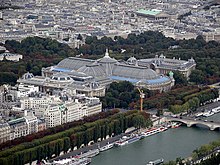Foire internationale d'art contemporain
The Foire internationale d'art contemporain (FIAC; German: "International Contemporary Art Fair ") is the most important French art fair , which takes place annually for a week in autumn in Paris . FIAC is a private event, so it is not hosted by the French Ministry of Culture.
Conceived after the model of the Basel art fair , the first FIAC took place in 1974 under the name Salon international d'art contemporain in the former Gare de la Bastille ( Bastille train station) in Paris. It was later renamed Foire internationale d'art contemporain and held successively at the Grand Palais and for many years at the Porte de Versailles before returning to the Grand Palais as a venue in October 2006.
organization
The Organization-Idées-Promotion (OIP) is an organization that has existed since 1974, which has specialized in the planning and design of various trade fairs (e.g. book fairs) and in particular the FIAC. It collects the stand fees and entrance fees of the FIAC, but in return takes care of the maintenance and the supply of turnkey exhibition stands, takes care of certain work in the Grand Palais and charges a fee based on the number of visitors to the French State off. Before the OIP was taken over by Reed Expositions in 2003/2004, Jean-Pierre Jouet was the commissioner of the OIP and Henri Jobbé-Duval was its artistic director.
The Comité d'organisation de la FIAC (COFIAC; German: "Organizing Committee of FIAC") selects the participating galleries and sets the guidelines. It consisted of Daniel Gervis (founder), Daniel Lelong (president), Denise René (vice president), Jean-Robert Arnaud (secretary), Pierre Nahon (treasurer) and a few other members before it was taken over by Reed Exposition was replaced by a new leadership committee.
Reed Expositions , a company that organizes more than 560 trade fairs annually in 59 different countries, took over the difficult successor after the acquisition of OIP when Jean-Daniel Compain, Director of the French subsidiary of Reed Exhibitions , signed up for the Reorganization of the FIAC began: He replaced the old management committee of the COFIAC and appointed a new artistic director: the former Parisian gallery owner Jennifer Flay , a New Zealander respected in the art scene. As a result, she succeeded in making a pointed selection of French and international galleries, and her name attracted new galleries from abroad, such as: B. Feign & Co from New York .
history
In 1973 the OIP, newly founded by Madame Deliot and Jean-Pierre Jouet, supported Daniel Talamoni's plans to hold a large art fair in France. After Talamoni had been assisted by Henri Jobbé-Duval since October 1973, he was also able to win Daniel Gervis for a first art fair. In January 1974 the first fair took place in the former Gare de la Bastille (Bastille train station). 24 galleries (e.g. Yvon Lambert, Iris Clert) exhibited at the premier salon international d'art contemporain (first international fair for contemporary art).
The second art fair in January 1975, again in the Gare de la Bastille, but now under the name Foire internationale d'art contemporain (FIAC), had a completely different dimension. After their positive response, the FIAC 1976 was to be held in the Grand Palais, where it finally stayed until 1994. In addition, the COFIAC was created in the course of restructuring, and Gervis was elected President in June 1975. Jouet and Gervis were able to win 15 galleries from the United States for the FIAC 1976 and thus improve the image of the art fair, which from now on takes place annually in October at the Grand Palais in Paris.
In 2002, 900 artists from 48 nations were represented at FIAC through their 169 galleries, which were divided into five areas: One man show, Group show, Perspectives (future-oriented area that offered young artists and gallery owners the opportunity to be discovered, and whose aim was to integrate contemporary trends), Édition and Vidéo cube (intended for the relatively young video art ).
In 2003/2004, OIP was taken over by Reed Expositions, which initiated a far-reaching redesign and restructuring process: On the one hand, Commissioner Martin Bethenod and the renowned former Parisian gallery owner Jennifer Flay took over as the new artistic director of FIAC. On the other hand, instead of the COFIAC, a new management committee was set up, consisting of two sections: on the one hand nine gallery owners who have voting rights, on the other hand five members from institutions, companies and the media who represent the consultative part. The main aim of the committee is to strike a balance between modern and contemporary European art. In 2004 an extra hall was opened for very young creations and the Futur Quake area was set up as an exhibition opportunity for galleries that are younger than three years. In addition, by integrating the field of design, an attempt was made to remove the boundaries between the various art disciplines.
A wide-ranging PR campaign enabled numerous galleries to be recruited for FIAC 2005 : 227 exhibitors took part from October 6 to 10, 2005, 113 of them from abroad. More than 83,000 visitors were recorded. In October 2006 the most important French art fair returned to the center of the French metropolis after several years in the exhibition park at the Porte de Versailles at the gates of Paris, where it has since been held in the renovated Grand Palais on the Champs-Élysées . In addition, in 2006 further exhibitions were opened in the Cour Carrée , an inner courtyard of the Louvre , in which mainly galleries of young artists were to be found. Compared to FIAC 2005, the number of invited galleries was reduced by a quarter to 169 galleries in 2006, partly for reasons of quality assurance . Ten of the 92 foreign galleries came from Germany.

